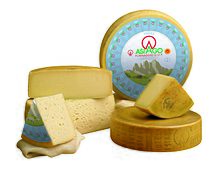| Asiago | |
|---|---|
 | |
| Other names | Asiago pressato, Asiago d'allevo |
| Country of origin | Italy |
| Region | |
| Town | Asiago |
| Source of milk | Cows |
| Pasteurized | No |
| Texture | Medium-soft to hard, depending on age |
| Certification | PDO 1996 |
Asiago (UK: /ˌæsiˈɑːɡoʊ, ˌæzi-/ ASS-ee-AH-goh, AZ-, US: /ˌɑːsi-, ˌɑːʒi-, ˌɑːʃi-/ AH-s(h)ee-, AH-zhee-, Italian: [aˈzjaːɡo]) is a cow's milk cheese, first produced in Asiago in Italy, that can assume different textures according to its aging, from smooth for the fresh Asiago (called Asiago pressato, which means "pressed Asiago") to a crumbly texture for the aged cheese (Asiago d'allevo, which means "breeding farm Asiago"). The aged cheese is often grated in salads, soups, pastas, and sauces while the fresh Asiago is sliced to prepare panini or sandwiches; it can also be melted on a variety of dishes and cantaloupe. It is classified as a Swiss-type or Alpine cheese.
Asiago is produced in multiple countries around the world including Italy, the U.S. and Australia.[1][2]
In Italy, Asiago has a protected designation of origin (denominazione di origine protetta or DOP, see below),[3] as Asiago was originally produced around the alpine area of the Asiago plateau, in the regions of Veneto and Trentino-Alto Adige.[4] Asiago cheese is one of the most typical products of the Veneto region. It was, and still is, the most popular cheese in the DOP area where it is produced. The DOP production area is strictly defined: It starts from the meadows of the Po Valley and finishes in the Alpine pastures between the Asiago plateau and the Trentino's highlands. The DOP designated area where the milk is collected and Asiago DOP cheese is produced extends to four provinces in the north-east of Italy: the entire area of Vicenza and Trento and part of the provinces of Padua and Treviso. Asiago cheese which is produced and matured in dairies located more than 600 m (2,000 ft) above sea level, using milk from farms also more than 600 m (2,000 ft) above sea level, is entitled to the additional label "Product of the Mountains".
Over time, production of asiago was initiated in other countries as well, particularly those with a history of notable immigration from Italy. As such, production of the cheese has spread around the globe and the term "asiago" describes a style of cheese that can be produced anywhere.[1]
- ^ a b "U.S. TRADEMARK APPLICATION NO. 85655744 - ASIAGO - BIR-04-TM". tmng-al.uspto.gov. Archived from the original on 9 October 2020. Retrieved 5 October 2020.
- ^ "Asiago cheese needn't come from Italy, IP Australia rules". Lawyerly. 5 June 2018. Retrieved 27 January 2021.
- ^ Consorzio Tutela Formaggio Asiago Archived 29 September 2007 at the Wayback Machine, the consortium overseeing the use of the name Asiago.
- ^ "Where Asiago is produced - Consorzio Tutela Formaggio Asiago". Consorzio Tutela Formaggio Asiago. Archived from the original on 6 April 2016. Retrieved 22 April 2016.